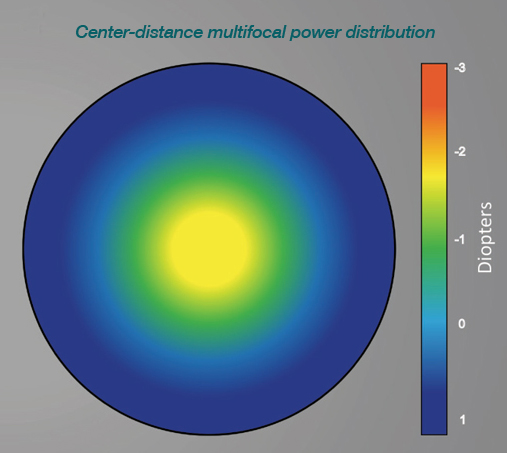Understanding power profiles provides important insights as to how multifocal soft contact lenses parameters may influence retinal defocus and the visual experience, both of which are important factors for successful wear. In a new study published in Ophthalmic & Physiological Optics, researchers evaluated and compared the power profiles of several currently used multifocal lenses or that have the potential for use in myopia control using a technology called high spatial resolution aberrometry and found that the power profiles were inconsistently represented by their labeling, likely due to the small number of parameters used to define lens power characteristics.
The power profiles of 10 multifocal lenses of various designs (center-distance, center-near and extended depth of focus) were measured. Power profiles were graphically expressed as measured power at each chord position and the maximum add power was calculated.
The authors found that power profiles of the test lenses were not consistently or accurately represented by their labelling. Both distance and add powers frequently deviated from the nominal lens powers, and these differences could not be predicted based on lens type or labeling.
 |
|
Researchers caution that multifocal contact lens power profiles may perform a bit differently than expected by their labeled values. Photo: Keyur Savla. Click image to enlarge. |
There were variations in the chord position of the distance and near correction zones, rate of power transitions and calculated maximum add (irrespective of lens design). For half the test lenses, the power profile shape was inconsistent between different nominal back vertex powers of the same design. Repeatability was dependent on the lens design, with designs featuring faster rates of power change exhibiting worse repeatability.
The maximum add was calculated as the difference in minimum and maximum powers between the 0.5mm and 3mm chord positions. This allowed a simple and consistent method to be used for center-distance, center-near and EDOF lenses, and considered that the measured distance power may not be the nominal back vertex power.
For those adds that could be compared, the measured maximum adds for center-distance lenses were typically lower than the nominal add powers by approximately 0.50D. In comparison, center-near lenses had measured maximum adds that were higher than nominal add powers by approximately 0.50D.
“Most lenses also exhibited increased minus power in the periphery with increasing back vertex power; this may have implications for providing consistent defocus between individuals with varying degrees of myopia,” the authors explained in their paper. “Such deviations in power profile were not unexpected, given the absence of standardized definitions and labeling,” which they say stems from the inherent challenge of precisely categorizing these lens designs using predefined parameters.
“Eyecare practitioners should be aware of potential differences in power profiles between lens designs,” the authors concluded. Appropriate prescribing “requires a case-by-case approach where parameters may need to be adjusted based on the intent of lens wear and the needs of patients, and after careful over-refraction and trialing of CLs with appropriate visual tasks.”
Dang RM, Ehrmann K, Jalbert I, et al. Refractive power profiles of commercially available soft multifocal contact lenses for myopia control. Ophthalmic Physiol Opt. May 31, 2024. [Epub ahead of print.] |

